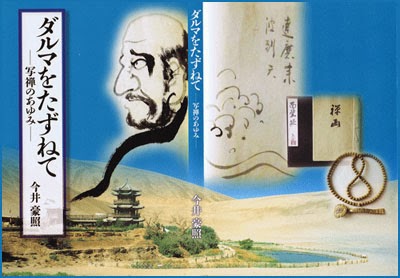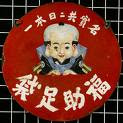[ . BACK to DARUMA MUSEUM TOP . ]
:::::::::::::::::::::::::::::::::::::::::::::::::::::::::::::::::::::::::::::::::::::::::::::::::::::
Santa Claus and Daruma San -Merry Christmas!
サンタさんとダルマさん ― クリスマス散歩
I have always wondered what would happen if Daruma meets Santa.
Here is what I overheared the two of them the other day.
 Daruma:
Daruma: Greetings to you, my younger brother!
Santa: Hi there, but don't call me in that anonymous Asian way. My name is Saint Nicolaus, but you may call me Claus, as all the others do. I hear you are a saint too?
Daruma: Yes, but here in Japan they don't call me Saint Daruma, they call me "Daruma Daishi", the Great Master. I always envy you since you have to work only once a year. Me, I have to use a lot of little clones to get over the New Year, but even after that I cannot rest. People pray to me for good luck and good business all year round.
Santa: Yea, I have seen your clones, all these little red dolls without arms or legs. You must have been doing some serious meditiation, haven't you, to loose all your limbs in that way. But tell me, why do you dye your beard? You must be almost as old as I am and my beard is all white! And why do you always wear a red robe? Me, if I don't, nobody would recognize me, but YOU?
Daruma:
Well, I come in many colors, forms and shapes, as you might have seen on this BLOG by Gabi san. I may have no arms and legs sometimes, but I am sure proud of my big black beard, I have been taking a lot of Chinese medicine and doing my martial arts exercises every day to keep me young. But I also have no eyelids and eyelashes, haven't you noticed?
Santa: Yes, your eyes are always sooo big and scary! And you drink a lot of tea to keep you awake, that's why you tossed our your eyelashes on the ground to have them grow into tea plants, right?
Daruma: A little miracle once in a while, just to keep me busy during meditation. Just sitting around doing nothing can be pretty boring sometimes, you know. But you, poor fellow, must be getting nuts this season, with all the kids waiting for presents!
Santa: I got my reindeers and my sledge, but Mrs. Santa has been complaining about this old-fashioned transportation lately, she wants a red Mercedes!
Daruma: At least I don't have to worry about that one. Me and my Princess, we always take the Shinkansen, since the streets around Japan are so crowded, we couldn't get anywhere in time even in a Mercedes. Did you know, they call them BENZ here in Japan!
Santa: Yea, the Japanese do many things different than anybody else, don't they! But no more time to muse about our similarities and differences, Big Red Brother. I really must run off, see you next year!
Daruma:
Hey, wait, wait, Santa Claus! You forgot to fill our stockings!
Gabi Greve, December 2002

:::::::::::::::::::::::::::::::::::::::::::::::::::::::::::::::::::::::::::::::::::::::::::::::::::::
. Santa Claus St. Nikolaus, Santa san
kigo for mid-winter
Daruma is one of the best-known Gaijin (外人) foreigner in Japan.
You can learn a little more about him in my introduction :
. Who is Daruma ?
:::::::::::::::::::::::::::::::::::::::::::::::::::::::::::::::::::::::::::::::::::::::::::::::::::::
Now I have a Christmas Medley for you, just to enjoy, while I was looking for the Santa-Daruma connection. If you have any more links, please let me know.
Chad sees a connection between Daruma and Santa. Here are his words:
"I think I like images of Santa for the same reasons I like Darumas. Both images are of mythic figures who combine both joy and sacrifice. The Daruma grants wishes and so does Santa. The Daruma and Santa are examples of folklore simplifying and humanizing religious figures."
...geocities.com/Tokyo/7540/SANTA.HTM
.......................................................................
Mrs. Santa:
Mrs. Claus came on the scene in 1889. She first appeared in a book entitled "Goody Santa Claus on a Sleigh Ride," by Catherine Lee Bates. (Goody is a contraction for "Goodwife".) And about her busy husband we can learn:
Due to the different time zones and the rotation of the Earth, Santa Claus actually has 31 hours to complete his work, providing he travels East to West.
Reference Mrs. Claus
Here are some impressions of the Japanese New Years events.
日本のお正月についてのお話もあります。
Children, of course, also look forward to having a few days off from school and to the promise of giftsムbut not from Santa Claus. He, and Christmas, have already come and gone. This important winter holiday, called "Oshogatsu" (oshoogatsu), is an ancient New Year's celebration, which remains a cornerstone of the Japanese festival calendar.
. The New Year in Japan and Haiku
If you are more into the tradidional European Christmas, have a look at the annual Chritsmas Market at Nurnberg, Christkindlesmarkt in Nuernberg.
もっと伝統的なクリスマス市場は毎年ドイツのヌレンベルグで開かれています。スライドショーがあります。
. . . CLICK here for Photos !
On a seasonal list of English words for Children we find
Santa Claus and the Snowman (Yuki Daruma).
If you are teaching English in Japan, this list might get you some ideas of FUN English, so I include it here.
子供達に英語を教える先生方のためにこほHPを紹介します。楽しい英語の勉強がいっぱい。雪達磨も登場します。
http://www.genkienglish.net/vocablist.htm
On their Flashcard List, you find Santa Claus and Yuki Daruma again.
塗り絵のフラッシュカードにサンタさんも、雪ダルマさんもあります。
http://www.genkienglish.net/clipart.htm
Christmas at the Japanese Toy Museum
日本玩具博物館のクリスマスとだるまさんの特別展示会。姫路のお話で、この博物館を紹介しました。
To celebrate the start of the New Year various symbols of happiness and good fortune dear to Japanese were shown in this building. Among the figures selected from the permanent collection of folk toys were the seven lucky gods, including Ebisu (god of wealth) and Daikoku (god of wealth), treasure ships, beckoning cats, and Daruma (roll-over toys of Bodhidharma). Other exhibitions about Christmas on this page include Christmas ornaments, trees and markets from all over the world. We have already visited this lovely museum in the story about Himeji.
http://www.japan-toy-museum.org/english/ekikaku2.htm

.................................................................................
"Daruma"
by Dr. Albert Cheknaov
Albert wrote about his Haiku experience, Chritsmas shopping and Daruma.
He writes Haiku, but recently found out that Japanese generally do not recognize English speaking Haiku as real ones. They just being polite by letting foreigners entertain themselves with their poetic efforts.
"Well, I decided that I should start writing in Japanese. But as I don't think it will happen very soon, please tolerate me one more time.
Daruma (Haibun)
Recently, while doing my Christmas shopping I found a store selling, among other things, Daruma dolls. Well, of course I've seen them before but there was a note and fortunately enough for me in English. It was saying that if you have a wish you should buy a doll (which looks like a head without body, of somewhat fierce appearance and with white spots in place of the eyes). Then you should paint one eye and wait until your wish comes true. If it does then you should paint another eye (and I don't know, keep it or bring it to a shrine, that's where I saw them before, all having two eyes)? Anyway, sure enough I spotted a one-eyed Daruma doll on a kaishain's desk when I walked past some company's office last night.
Winter morning .....
I lay still for
quite a while
with one eye opened!
- quote : toyota-ti.ac.jp -
Mary Christmas, Albert, as the Japanese say, or maybe marry Christmas! And many more Haiku next year!
 - quote facebook -
- quote facebook -
.................................................................................
Daruma as a Snowman
. Yukidaruma 雪だるま Daruma as a Snowman
:::::::::::::::::::::::::::::::::::::::::::::::::::::::::::::::::::::::::::::::::::::::::::::::::::::
Hungarian Daruma
Christmas Gifts
 quote
quote
I started this painting like 6 months ago for the longest time it was just a daruma on a piece of wood for Christmas I decided to finish the painting by adding Hungarian (since Laura's family is Hungarian) flower designs inspired by their traditional style of embroidery,
Kalocsa.
This seems to be something I have been doing combining Daruma's and western European culture, I hope it isn't too culturally insensitive of me, I just love the design of the Daruma as well as the cultural meaning. Surprisingly I think that the flowers and the daruma work well together and the Kalocsa was a fun style to work in.
source : Eric Royal Arts
:::::::::::::::::::::::::::::::::::::::::::::::::::::::::::::::::::::::::::::::::::::::::::::::::::
 source : atsuko blog
source : atsuko blog
:::::::::::::::::::::::::::::::::::::::::::::::::::::::::::::::::::::::::::::::::::::::::::::::::::
Santa Daruma 2020
:::::::::::::::::::::::::::::::::::::::::::::::::::::::::::::::::::::::::::::::::::::::::::::::::::
source : はかた伝統工芸館
:::::::::::::::::::::::::::::::::::::::::::::::::::::::::::::::::::::::::::::::::::::::::::::::::::
Santa Claus, a KIGO
[ . BACK to DARUMA MUSEUM TOP . ]
[ . BACK to WORLDKIGO . TOP . ]
- #santadaruma #darumasanta -
:::::::::::::::::::::::::::::::::::::::::::::::::::::::::::::::::::::::::::::::::::::::::::::::::::::

































































